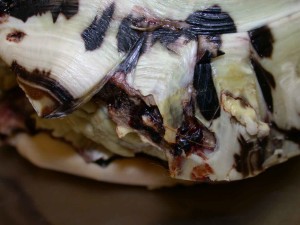Shell injuries to turtles and tortoises present both cosmetic and functional problems which often necessitate the repair of the damaged shell. A variety of materials may be used to repair shell damage. These materials include fiberglass, epoxy and dental acrylic. Acrylic provides the most cosmetic repair. Most acrylic kits are of the type used to make temporary dental repairs. What follows is an example of an acrylic repair for an injured Leopard Tortoise….
Before any repair can be undertaken, it is essential that the affected area be clean and free of any infection. This condition for repair may require several days of cleaning, flushing and antibiotics. Once the site is deemed ready, the repair process may be begun.

Figure 1. In this image an injury to the edge of the shell may be clearly seen. The shell defect has exposed dermal bone and, if left untreated, is open to re-infection.
 Figure 2. Surgical steel posts and mesh are placed to gap the defect. This hardware is intended to provide support and strength to the acrylic.
Figure 2. Surgical steel posts and mesh are placed to gap the defect. This hardware is intended to provide support and strength to the acrylic.
 Figure 3. A smooth sheet of copper foil is positioned and taped along the lower surface of the defect. This will facilitate the retention of the liquid acrylic until it hardens within the defect site.
Figure 3. A smooth sheet of copper foil is positioned and taped along the lower surface of the defect. This will facilitate the retention of the liquid acrylic until it hardens within the defect site.
 Figure 4. Dental acrylic is mixed and poured into the defect site. After the acrylic hardens, the copper foil is removed and the acrylic shaped and sanded. Dental acrylic may be mixed in a variety of colors, or the finished product may be illustrated to closely match the missing shell’s color and pattern.
Figure 4. Dental acrylic is mixed and poured into the defect site. After the acrylic hardens, the copper foil is removed and the acrylic shaped and sanded. Dental acrylic may be mixed in a variety of colors, or the finished product may be illustrated to closely match the missing shell’s color and pattern.
Acrylic shell repairs are typically very durable and water-resistant. Repairs may be left in place indefinitely in full-grown tortoises, but actively growing tortoises may require occasional removal and replacement of acrylic shell patches. The acrylic, because it does not grow with the tortoise, may interfere with normal shell growth.
An acrylic patch may also protect the underlying dermal bone long enough for it to form enough scar tissue that it may not require further protection. Once gone, normal shell will not regrow.
Michael S. Samuels, D.V.M.
Central Animal Hospital